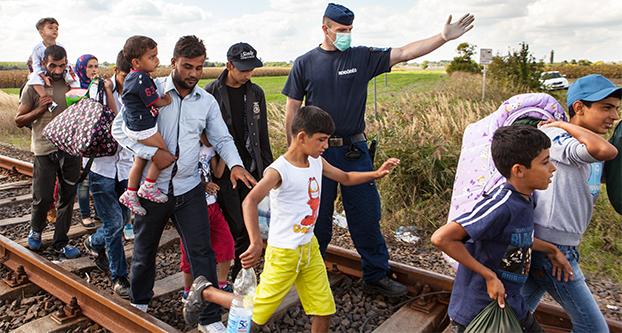For 10 days, former Fresno State student Antonio Olmos’ eyes told the story of the refugee crisis in Europe through his camera.
Olmos is a London-based freelance photojournalist and was sent by British newspapers The Guardian and The Observer into Hungary after the government closed the main railway station in Budapest on Sept. 2 in response to the flood of refugees attempting the trek to Western Europe.
“I got sent because the government stopped all the trains going to Austria,” Olmos said. “So I flew in the next day because that was a big story and caused this huge bottleneck of refugees at the station,” he said.
Olmos found the situation in Hungary to be that of a modern European country from when he landed at the airport until he entered his hotel room. It all changed when he went to the Keleti railway station.
“It was completely amazing, chaotic scenes of thousands of refugees camped in a railway station,” Olmos said. “It’s a beautiful Austrian-Hungarian building. It’s gorgeous, but it was camped out with thousands of refugees — mostly from Syria — trying to get a train to Austria and then on to Germany,” he said.
The freelance photojournalist visualized the mass of refugees impacting a place familiar to many Americans, the mall.
“Imagine going to Fresno and going to Fashion Fair and suddenly realize that there’s like 4,000 people camped out trying to get asylum,” Olmos said. “It’s just incredible you know,” he said.
The majority of refugees that have been pouring into Hungary and the rest of the European Union have been escaping the horrors of the Syrian Civil War.
About 108,000 civilians have been killed in a conflict that has been raging for four years, according to the Syrian Observatory for Human Rights.
About 4 million registered Syrian refugees escaped the civil war and now live in camps spread across the Middle East, according to figures compiled by the U.N. Refugee Agency and the Government of Turkey.
Out of those millions, only 10 percent seek asylum in Europe according to the U.N. agency. The refugee agency reported that about 348,000 Syrians have sought asylum in the Europe from April 2011 to July 2015 — with 138,000 applicants in 2014 alone. The agency said that this figure has steadily increased, even though the numbers are still comparatively low.
Olmos treats each story he covers differently, but he related the current refugee crisis in Europe to the Nicaraguan refugee crisis he covered when he started working for The Miami Herald in 1989.
“The Miami Herald sent me to Nicaragua to follow a group of refugees as they made their way from Nicaragua, all the way to the United States,” Olmos said. “And that was a very moving story that I really still remember 26 years later I guess,” he said.
The freelance photojournalist “But it’s incredible, it’s really weird to be a witness to this stuff. It’s really biblical,” Olmos said.
Olmos thought of the risks refugees took to get from Syria to the safety of Europe.
“You know it’s tens of thousands of people and you think of how far Syria is from Germany and how it’s a very dangerous journey: They’ve got to get on boats, they’ve got to cross through hostile territory, they’ve got to walk, they’ve got to get on a train, they have so many things they have to do,” Olmos said.
Despite the Hungarian government’s hardline stance on the refugees, Olmos saw the exact opposite in its citizens during the closure of the railway station.
“I saw hundreds of Hungarian volunteers giving food, helping people with clothes, all kinds of generosity, people bringing in toys, street performers coming in to perform for the kids, to keep the kids entertained,” Olmos said.
“They hired hundreds of busses and they were shipped to the Austria-Hungary border,” Olmos said. “The trouble is, the next day, the station started filling with refugees again. But the trains are running, but they have riot police guarding the gates. So they refused to let any refugees to get on the trains.”
The refugee crisis affecting Hungary wasn’t just limited to the train station in its capital. Some refugees started to leave the station in frustration after waiting there for days. Austria and a ticket to the rest of Europe were in their sites.
“A lot of the refugees left the station to march to the Austrian border and there was like several thousand that were walking literally [along the highway],” Olmos said. “Imagine 3,000 people walking along Highway 5 from Los Angeles to San Francisco, that’s what they were doing,” he said.
Germany announced on Sunday that it was reimplementing border controls with Austria due to the crush of migrants flooding into the country. The German Interior Ministry cited security concerns and requested the establishment of processing facilities for migrants along its borders.
The freelancer and his colleagues also covered refugees pouring into the country from Hungary’s southern border with Serbia.
“I was covering the refugees crossing from Serbia into Hungary, the border crossing there, and that was very interesting,” Olmos said. “We saw at least a thousand people cross today. That’s every day they’re doing this. It’s just incredible and that’s just one crossing point. There are other crossing points we didn’t even go to,” he said.
Olmos said covering events like the European refugee crisis was one of the reasons he became a journalist.
“I’m just very lucky to be able to witness it,” Olmos said. “I wish I wasn’t witnessing it, I wish it wasn’t happening, but it’s happening. So it’s one of the reasons why I became a journalist because I wanted to be able to witness all these kind of things, instead of watching it on TV.”




